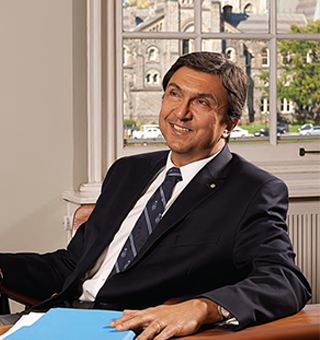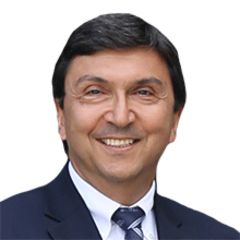As my term winds down this fall, I have been taking in that view with a few pangs of nostalgia. Mostly, however, I feel very grateful for the privilege of working with so many extraordinary people in the immediate and extended U of T family over the last eight years. There is no network in Canada – indeed, there are few worldwide – that can match the diverse backgrounds, roles, interests and talents of the 20,000 faculty and staff, 80,000 students, 525,000 alumni and countless other supporters and partners across the globe who are linked in some way to our university.
Today, Toronto is the clear leader among Canadian universities. And in one assessment after another, it is also Canada’s strongest global contender in a world where the pipeline of well-educated people with great ideas is the most important natural resource of all.
Our standing has arisen from the efforts and accomplishments of successive generations who have been part of the university community in distinctive ways. Fortunately, U of T continues to be blessed with faculty who are boundlessly creative, with staff whose dedication is immeasurable and with brilliant students drawn increasingly from every corner of the globe. It hardly needs stating, therefore, that any progress we have made in recent years is a function of distributed leadership stretching into every corner of the university’s three campuses and all the other sites – not least many world-renowned hospitals – where faculty, staff, and students gather and learn.
None of that progress would have been possible without the loyalty and vision of so many alumni and friends. From them we have received untold hours of volunteer time and record-setting levels of philanthropic support. Indeed, philanthropy has lifted every part of U of T, and, perhaps most importantly, helped to keep the university open to meritorious students regardless of means.
This last thought takes me back to the president’s office – and then back in time. In recent weeks, I have been boxing up books, organizing files and deciding what to do with the memorabilia that had spread from the mantelpiece to almost every flat surface in my office. Only one item of furniture, however, actually needs to be moved out: my father’s small oak desk dating from the 1930s. Its presence there – and previously in the office of the dean of medicine – is not without some irony given the relevant history.
Thomas Lachowitz and Edna Aziz were both born in Ontario almost exactly 100 years ago. Edna’s father had been part of the wave of Christian immigrants from Lebanon and Syria that began towards the end of the 19th century. He settled in eastern Ontario and worked between farms and stores as a fruit wholesaler. Tom’s father was part of another group that sought refuge and opportunity in Canada. He came here from the Jewish ghetto of Lvov near the Polish- Ukrainian border, and eventually found work driving a horse-drawn milk cart in Toronto.
As was the custom in those days, Tom’s and Edna’s mothers were both homemakers. And as remained the norm, although Edna won top honours at her high school, university was never considered. In 2013, by way of happy contrast, 56 per cent of our students are women.
Tom was the only one of six siblings to attend university. He registered at UC, hoping to pursue a career in medical research. Along the way, he adopted a new surname. Short of cash and working full time, Tom failed a course in second year, managed to make it up over the summer and was admitted to medicine. He dropped out in his first year to stay afloat financially, and never returned – a story that, I am again happy to say, would have a very different ending today.
There was, in any case, another beginning. Tom and Edna eloped in 1940. All four of their children eventually earned PhDs and have taught at Canadian universities. Three came to U of T as undergraduates. One never really left – and is today somewhat baffled to be writing these words at 93 Highland Avenue, the residence of eight successive presidents of this nation’s finest university.
I share this narrative precisely because it is unremarkable. With countless variations, many involving significant sacrifice and struggle, this story has been repeated through the decades in describing the intergenerational path of a high proportion of U of T alumni and their families. The ending – or beginning, if you will – plays out each year at Convocation Hall as thousands of our newest graduates come on stage before their proud family members, friends and spouses. And while these varied stories are especially poignant and uplifting in this nation of immigrants, a similar narrative of aspiration and opportunity recurs for students from every imaginable social, economic and cultural background. Indeed, it recurs at universities and colleges around the world.
Therein lies the enduring magic of higher education. One sees it as undergraduate students grow from awkward teenagers into impressive young adults, and in the dazzling development of students in our graduate and professional programs. Listening to the reflections of our alumni, I have been struck repeatedly by the impact of their university years on the arc of their lives. And to affirm the power of this educational magic and its enduring relevance, one need only consider the stellar accomplishments of our alumni in more than 180 countries who are doing so much to make the world a better place.
This impact on the world will clearly continue for a very long time. Our university, founded in 1827, is a mere teenager compared to some sister institutions ranging from 500 to more than 800 years old. It is accordingly a very safe bet that, 186 years from now, the University of Toronto will still matter to Canada and the world – and it will continue to be lifted by the cycle of renewal and optimism that begins with each new wave of students, alumni, staff and faculty.
Part of that renewal, of course, is leadership succession. I look forward to supporting the university’s 16th president, Meric Gertler – an outstanding individual who has been one of our best and brightest for over three decades. And as U of T’s 15th president, I leave office feeling both fortunate and humbled to have been part of the stewardship of this great good place. For that privilege, and for a lifetime of wonderful memories, I will always be deeply thankful.
Sincerely,
David Naylor
Recent Posts
U of T’s 197th Birthday Quiz
Test your knowledge of all things U of T in honour of the university’s 197th anniversary on March 15!
Are Cold Plunges Good for You?
Research suggests they are, in three ways
Work Has Changed. So Have the Qualities of Good Leadership
Rapid shifts in everything from technology to employee expectations are pressuring leaders to constantly adapt






